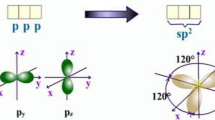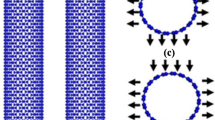Abstract
Electromagnetic and thermo-mechanical forces play a major role in nanotube-based materials and devices. Under high-energy electron transport or high current densities, carbon nanotubes fail via sequential fracture. The failure sequence is governed by certain length scale and flow of current. We report a unified phenomenological model derived from molecular dynamic simulation data, which successfully captures the important physics of the complex failure process. Length-scale and strain rate-dependent defect nucleation, growth, and fracture in single-walled carbon nanotubes with diameters in the range of 0.47 to 2.03 nm and length which is about 6.17 to 26.45 nm are simulated. Nanotubes with long length and small diameter show brittle fracture, while those with short length and large diameter show transition from ductile to brittle fracture. In short nanotubes with small diameters, we observe several structural transitions like Stone-Wales defect initiation, its propagation to larger void nucleation, formation of multiple chains of atoms, conversion to monatomic chain of atoms, and finally complete fracture of the carbon nanotube. Hybridization state of carbon-carbon bonds near the end cap evolves, leading to the formation of monatomic chain in short nanotubes with small diameter. Transition from ductile to brittle fracture is also observed when strain rate exceeds a critical value. A generalized analytical model of failure is established, which correlates the defect energy during the formation of atomic chain with aspect ratio of the nanotube and strain rate. Variation in the mechanical properties such as elastic modulus, tensile strength, and fracture strain with the size and strain rate shows important implications in mitigating force fields and ways to enhance the life of electronic devices and nanomaterial conversion via fracture in manufacturing.






Similar content being viewed by others

References
Agrawal PM, Sudalayandi BS, Raff LM, Komanduri R (2008) Molecular dynamics (MD) simulations of the dependence of C −C bond lengths and bond angles on the tensile strain in single-wall carbon nanotubes (SWCNT). Comput Mater Sci 41(4):450–456
Baloch KH, Voskanian N, Bronsgeest M, Cumings J (2012) Remote Joule heating by a carbon nanotube. Nat Nanotechnol 7(5):316–319
Bonard JM, Klinke C, Dean KA, Coll BF (2003) Degradation and failure of carbon nanotube field emitters. Phys Rev B 67(11):115,406
Brenner DW (1990) Empirical potential for hydrocarbons for use in simulating the chemical vapor deposition of diamond films. Phys Rev B 42(15):9458–9471
Collins PG, Hersam M, Arnold M, Martel R, Avouris P (2001) Current saturation and electrical breakdown in multiwalled carbon nanotubes. Phys Rev Lett 86(14):3128–3131
Dereli G, Süngü B (2007) Temperature dependence of the tensile properties of single-walled carbon nanotubes: O(N) tight-binding molecular-dynamics simulations. Phys Rev B 75(184):104
Fereidoon A, Ghorbanzadeh AM, Ganji MD, Jahanshahi M (2012) Density functional theory investigation of the mechanical properties of single-walled carbon nanotubes. Comput Mater Sci 53:377–381
Gadzuk JW, Plummer EW (1973) Field emission energy distribution (FEED). Rev Mod Phys 45(3):487–548
Gupta S, Dharamvir K, Jindal VK (2005) Elastic moduli of single-walled carbon nanotubes and their ropes. Phys Rev B 72(165):428
Huang JY, Chen S, Jo SH, Wang Z, Han DX, Chen G, Dresselhaus MS, Ren ZF (2005) Atomic-scale imaging of wall-by-wall breakdown and concurrent transport measurements in multiwall carbon nanotubes. Phys Rev Lett 94 (23):236– 802
Humphrey W, Dalke A, Schulten K (1996) VMD: Visual Molecular Dynamics. J Mol Graph 14:33–38
Jiang JW, Wang JS (2011) Joule heating and thermoelectric properties in short single-walled carbon nanotubes: electron-phonon interaction effect. J Appl Phys 110(12):124,319
Kingrey D, Khatib O, Collins PG (2006) Electronic fluctuations in nanotube circuits and their sensitivity to gases and liquids. Nano Lett 6:1564–1568
Meo M, Rossi M (2007) A molecualr-mechanics based finite element model for strength prediction of single wall carbon nanotubes. Mater Sci Eng A 454:170–177
Nardelli MB, Yakobson BI, Bernholc J (1998) Brittle and ductile behavior in carbon nanotubes. Phys Rev Lett 81:4656–4659
Narendar S, Roy Mahapatra D, Gopalakrishnan S (2011) Prediction of nonlocal scaling parameter for armchair and zigzag single-walled carbon nanotubes based on molecular structural mechanics, nonlocal elasticity and wave propagation. Int J Eng Sci 49(6):509–522
Obitayo W, Liu T (2012) A review: carbon nanotube-based piezoresistive strain sensors. J Sens e652:438
Plimpton S (1995) Fast parallel algorithms for short-range molecular dynamics. J Comput Phys 117:1–19
Ranjbartoreh AR, Wang G (2010) Consideration of mechanical properties of single-walled carbon nanotubes under various loading conditions. J Nanopart Res 12:537–543
Rinzler AG, Hafner JH, Nikolaev P, Lou L, Kim SG, Tománek D, Nordlander P, Colbert DT, Smalley RE (1995) Unraveling nanotubes: field emission from an atomic wire. Science 269:1550–1553
Samsonidze GG, Samsonidze GG, Yakobson BI (2002) Energetics of Stone-Wales defects in deformations of monoatomic hexagonal layers. Comput Mater Sci 23:62–72
Seidel RV, Graham AP, Rajasekharan B, Unger E, Liebau M, Duesberg GS, Kreupl F, Hoenlein W (2004) Bias dependence and electrical breakdown of small diameter single-walled carbon nanotubes. J Appl Phys 96 (11):6694– 6699
Singh DK, Giri PK, Iyer PK (2011) Evidence for defect-enhanced photoluminescence quenching of fluorescein by carbon nanotubes. J Phys Chem C 115(49):24,067–24,072
Sinha N, Mahapatra DR, Sun Y, Yeow JTW, Melnik RVN, Jaffray DA (2007) Carbon nanotube thin film field emitting diode: understanding the system response based on multiphysics modelling. J Comput Theor Nanosci 4:535–549
Sinha N, Mahapatra DR, Sun Y, Yeow JTW, Melnik RVN, Jaffray DA (2008) Electromechanical interactions in a carbon nanotube based thin film field emitting diode. Nanotechnology 19(2):025,701
Song J, Jiang H, Shi DL, Feng XQ, Huang Z, Yu MF, Hwang KC (2006) Stone-Wales transformation: precursor of fracture in carbon nanotubes. Int J Mech Sci 48:1464–1470
Stuart SJ, Tutein AB, Harrison JA (2000) A reactive potential for hydrocarbons with intermolecular interactions. J Chem Phys 112:6472–6485
Subramaniyan AK, Sun CT (2008) Continuum interpretation of virial stress in molecular simulations. Int J Solids Struct 45:4340–4346
Swope WC, Andersen HC, Berens PH, Wilson KR (1982) A computer simulation method for the calculation of equilibrium constants for the formation of physical clusters of molecules: application to small water clusters. J Chem Phys 76:637
Tang C, Wanlin G, Changfeng C (2009) Molecular dynamics simulation of tensile elongation of carbon nanotubes: temperature and size effects. Physical Review B 79:155,436–1–155,436–9
Tiwary CS, Javvaji B, Kumar C, Mahapatra DR, Ozden S, Ajayan PM, Chattopadhyay K (2015) Chemical-free graphene by unzipping carbon nanotubes using cryo-milling. Carbon 89:217–224
Tsutsui M, Taninouchi YK, Kurokawa S, Sakai A (2006) Electrical breakdown of short multiwalled carbon nanotubes. J Appl Phys 094(9):302
Varadan VK (ed) (2012) Electromagnetic characteristics of carbon nanotubes with strain, vol 8344
Wang J, Lu C, Wang Q, Xiao P, Ke F, Bai Y, Shen Y, Wang Y, Chen B, Liao X, Gao H (2012) Self-healing in fractured GaAs nanowires. Acta Mater 60:5593–5600
Wei W, Liu Y, Wei Y, Jiang K, Peng LM, Fan S (2006) Tip cooling effect and failure mechanism of field-emitting carbon nanotubes. Nano Lett 7(1):64–68
Williams L, Kumsomboone V, Ready W, Walker M (2010) Lifetime and failure mechanisms of an arrayed carbon nanotube field emission cathode. IEEE Trans Electron Devices 57(11):3163–3168
Yuzvinsky TD, Mickelson W, Aloni S, Konsek SL, Fennimore AM, Begtrup GE, Kis A, Regan BC, Zettl A (2005) Imaging the life story of nanotube devices. Appl Phys Lett 87(8):083,103
Zhang Y, Zheng L, Sun G, Zhan Z, Liao K (2012) Failure mechanisms of carbon nanotube fibers under different strain rates. Carbon 50:2887–2893
Zhao J, Zhu J (2011) Electron microscopy and in situ testing of mechanical deformation of carbon nanotubes. Micron 42(7):663–679
Acknowledgements
The authors gratefully acknowledge financial support under the Computational Nanoengineering (CoNE) project, NPMASS, Govt. of India. BJ and DRM gratefully acknowledge financial support under ACECOST Phase-III program of Aeronautics Research & Development Board, Government of India.
Author information
Authors and Affiliations
Corresponding author
Ethics declarations
Conflict of interest
The authors declare that they have no conflict of interest.
Rights and permissions
About this article
Cite this article
Javvaji, B., Raha, S. & Mahapatra, D.R. Length-scale and strain rate-dependent mechanism of defect formation and fracture in carbon nanotubes under tensile loading. J Nanopart Res 19, 37 (2017). https://doi.org/10.1007/s11051-016-3735-0
Received:
Accepted:
Published:
DOI: https://doi.org/10.1007/s11051-016-3735-0



